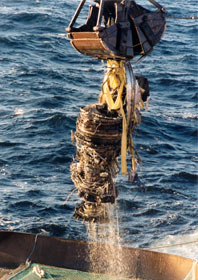|
On the evening of September 2, 1998, a Swissair MD-11 jet bound from
New York to Geneva diverted to Halifax, Nova Scotia, after the crew
smelled smoke in the cockpit. Just minutes from the airport, Flight
111 plunged into the ocean, killing all 229 people aboard. "Crash of
Flight 111" tells the behind-the-scenes story of the quest for the
cause of this tragic accident.
NOVA was given unprecedented access to one of the most intricate
aviation investigations ever mounted, which cost $39 million, took
more than four years, and involved a seemingly hopeless search for
evidence among two million pieces of debris scattered across the
seafloor. Through painstaking detective work, investigators
eventually pinned the cause of the accident to a chain of events set
off by conditions that still exist on many planes today.
After what appeared to be a minor smoke problem developed aboard
Flight 111, the pilots headed for the nearest airport, Halifax
International, for a nonemergency landing. On approach, they decided
it would be safer if they first dumped fuel over the ocean in order
to lighten the aircraft.
Matters grew rapidly worse. As the plane turned away from the
airport, the autopilot mysteriously disconnected. Then something
apparently catastrophic happened that caused both pilots
simultaneously to declare an emergency. Seconds later controllers
lost contact with the plane. Six minutes after that, residents along
St. Margaret's Bay near Peggy's Cove heard Flight 111 hit the water
and disintegrate.
Though divers soon recovered both black boxes—the flight data
recorder and cockpit voice recorder—neither device preserved
information from the final six minutes, thus deepening the mystery
of what occurred to bring the aircraft down. Despite these
obstacles, crash detectives from Canada's Transportation Safety
Board methodically collected, sifted, sorted, and reassembled a
large fraction of the plane in a giant hangar, where they slowly
built a detailed picture of Flight 111's final moments.
The recovery was aided by the Queen of the Netherlands, a
salvage ship known as the world's largest floating vacuum cleaner,
which sucked fragments of the plane off the bottom of St. Margaret's
Bay, including components that were later implicated in the crash.
Investigators also performed flame tests on cabin insulation, which
proved unexpectedly combustible, and they ran exhaustive failure
scenarios in an MD-11 flight simulator.
As the pieces of the puzzle fell into place, the crash detectives
arranged a flight to re-create the jet's final path in similar
lighting and weather, hoping for clues to the terrifying last
seconds aboard Flight 111—with main instruments dead, smoke
filling the cockpit, featureless gloom out the window, and no way to
know that the plane was veering out of control.


|


|
A crane lifts wreckage of Swissair Flight 111 that was
retrieved from the seafloor off Peggy's Cove, Nova
Scotia.

|
|
|

